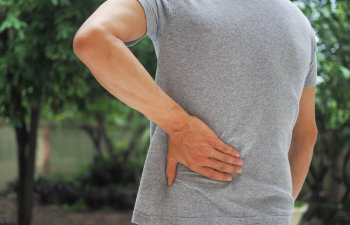
Similar to the eerily misunderstood Bermuda Triangle, a less frequently discussed hernia can occur in the lumbar triangle—a small anatomical region in the lower back. Understanding the risks and recognizing the symptoms of lumbar hernias is crucial for early diagnosis and treatment. The hernia specialists at Core Surgical in NYC share more.
What is a Lumbar Hernia?
A lumbar hernia occurs when tissue, such as part of the intestine, protrudes through a weak spot in the abdominal wall in the lumbar region. The lumbar triangle, also referred to as the Petit triangle, is located in the lower back and is bordered by the iliac crest, the latissimus dorsi muscle and the external oblique muscle. Although lumbar hernias are rare, they can lead to severe complications if left untreated.
Several factors may contribute to the development of a lumbar hernia, including:
- Weakening Muscles: Aging or physical strain can weaken the muscles of the abdominal wall.
- Genetic Predisposition: Some individuals may have a predisposition to hernias due to genetics.
- Injury or Trauma: Physical injuries to the lower back can create openings where herniation can occur.
- Increased Abdominal Pressure: Conditions that increase abdominal pressure, such as obesity or heavy lifting, can also contribute.
Symptoms of a Hernia in the Petit Triangle
Recognizing the signs of a lumbar hernia is crucial for prompt treatment. Common symptoms include:
Pain in the Lower Back: This could be local to the area of the lumbar triangle or radiate through the surrounding areas.
- Visible Bulge
- Discomfort During Movement
- Nausea or Digestive Issues
- Weakness or numbness in one leg or foot
- Shooting pain down one side of the buttock into the leg
Diagnosis and Treatment
If you suspect a lumbar hernia, it’s crucial to consult the hernia professionals at Core Surgical. Diagnosis typically involves a thorough physical examination and imaging studies, such as an MRI or CT scan, to assess the extent of the hernia.
Treatment options may vary depending on the severity and the symptoms present:
- Conservative Management: For mild cases, rest, physical therapy, and pain management might be sufficient.
- Surgical Intervention: If the hernia is significant or causing severe symptoms, surgery may be required to repair the abdominal wall and prevent complications.
At our medical center in Midtown Manhattan, we offer laparoscopic hernia repair. Our board-certified specialists can use this method to repair many lumbar hernias with minimal scarring and recovery downtime.
NYC Lumbar Hernia Treatment, Surgery
Though uncommon, lumbar hernias can lead to serious health issues if not addressed promptly. Being aware of the symptoms and risk factors associated with this condition is essential for anyone, especially those who engage in strenuous physical activities or have a family history of hernias. Early diagnosis and appropriate treatment can significantly improve outcomes, allowing for a return to daily activities without discomfort. If you experience any signs of a lumbar hernia, contact Core Surgical to schedule an exam and evaluation with one of our hernia specialists.
Posted on behalf of
133 E 58th St Suite 703
New York, NY 10022
Phone: (212) 628-8771
Email: frontdesk@coresurgicalmd.com
Monday - Thursday: 9:00AM to 5:00PMFriday: 9:00AM to 4:00PM
Saturday - Sunday: Closed
